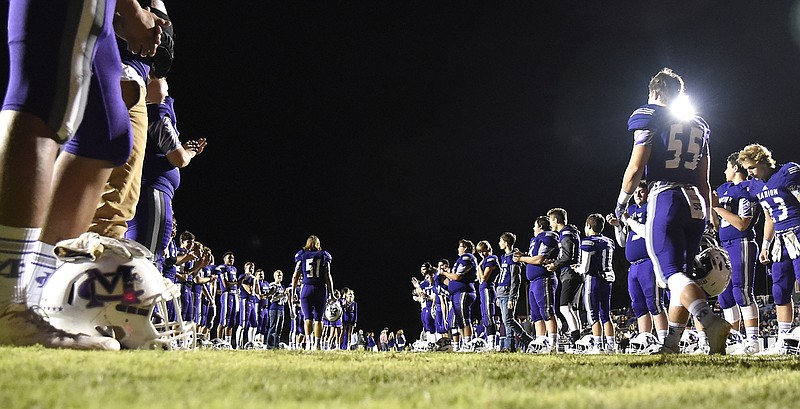The debate over whether high school and even college football should be played amid the COVID-19 pandemic has grown over the past few weeks. In a time when opinions are shouted so loudly on social media that they become static noise, a dividing line has been drawn, leaving no room for straddling the fence.
For my part, even if I weren't getting paid to do so, I would still be at a prep football game somewhere every Friday night in the fall. The atmosphere surrounding the sights and sounds of the game, as well as seeing what it means to the kids to represent their school and their community, is something uniquely special.
So when Gov. Bill Lee's office as well as the TSSAA agreed three weeks ago to set in motion a list of guidelines that would allow the games to be played, it came as no surprise that the decision was applauded by the majority of folks in Tennessee.
That decision was reached only after much discussion and input from medical experts such as Dr. David Bruce, who specializes in pediatric sports medicine at Erlanger Orthopedics and has been a proponent statewide for helping young people resume athletics. He worked as an advisor to the TSSAA as well as both Baylor and McCallie on protocols for their plans on returning to play.
Dr. Bruce is unwavering in his belief that the risks to young people by not allowing them to play far outweigh those attached to the coronavirus.
"There's no doubt COVID-19 is bad. For the older population and people with preexisting health issues, there's a danger that is worse than the flu," Dr. Bruce said. "But that's not the case at all for kids. For young adults, particularly those 18 and under, the data tells us this virus is nowhere near as dangerous as the flu.
"So far there have been fewer than 100 kids under the age of 16 who have died from this, while last year alone the flu killed nearly 500 kids in that same age group, but we didn't shut down athletics because of it.
"My head is not in the sand. There are people who fall into the category of needing to avoid exposing themselves to certain settings, but everyone should understand the downstream effects of taking things away from young people. There are risks that are far greater than this virus, which has an extremely high recovery rate for them."
According to a Centers for Disease Control and Prevention report published last week, depression among adolescents doubled during the quarantine and one-quarter of the nation's young people has contemplated suicide - which is the second-leading cause of death for teens ages 16-24, behind only automobile accidents - during the pandemic. The same study, which painted a bleak picture of the mental health issues caused by the pandemic, also pointed out a noticeable surge in anxiety and substance abuse in young people since the beginning of this year.
Another study by Dr. Tim McGuine, who works in the sports medicine program at the University of Wisconsin School of Medicine and Public Health, gauged the impact of school closures on the quality of life for young people. The findings by Dr. McGuine's team of physicians, which were recently cited by the TSSAA, showed that among more than 13,000 high school respondents there was a clear need for young people to return to their in-person school settings and athletic competitions.
"It was incredibly, incredibly striking," Dr. McGuine told the TSSAA. "We know that depression scores in athletes are usually pretty low. But in this new sample, 68% scored high enough on depression screenings that, in a normal clinical situation, it would trigger a referral to get the kid extra help.
"The only scores (for depression) higher than these were kids with chronic conditions such as cancer, cerebral palsy, diabetes, things like that."
A few points by those arguing loudest against allowing sports to return have stood out.
First is the fear factor. Fear is a rational reaction, especially to things we don't understand or aren't educated in. But fear typically provokes people to respond out of emotion rather than basing decisions on fact, so while it is right to fear the virus, should we let it dictate every activity in our daily lives?
We all face a certain amount of risk every day, and that is especially true for football players. It's why an ambulance is parked near the field at every level of play. But based on the data we've been provided, while we can all agree that even one young person's death is too many, the decision over whether or not it's too risky to allow them to play should be left up to their parents.
Youth league baseball and AAU basketball games have been played during the pandemic, often with fans in the stands, and even numerous football camps were held with hundreds of participants, all without drawing much debate. That's because, aside from family members, those activities don't attract nearly the same attention as football, which is by far the most popular youth sport in the nation.
And while the virus may not care about people's personal political views, it's definitely worth noting that 25 of the 26 states with Republican governors will be playing high school football while only seven of the 22 states with Democratic governors are allowing the season to be played. Two more states with Democratic governors have not yet announced a decision on whether they will allow the season to be played.
At the collegiate level, where the Big Ten and Pac-12 conferences voted to cancel their fall sports seasons, athletes will still be allowed to practice up to 20 hours per week, which can only lead us to believe those decisions came more from the fear of potential future legal challenges than the actual safety of the players.
"The Big Ten based their decision on two medical articles," Dr. Bruce said. "One in which the youngest patient was 45 years old, so it isn't a true comparison of college-aged athletes, and another that reported the potential for myocarditis (inflammation of the heart muscle). What they didn't add is that we see myocarditis every year in young athletes because some of the main causes of it are from streptococcus and other non-COVID-19 viruses.
"We've never shut down athletics over the flu or strep or the common cold. Any sanity that's involved in this would tell people to actually look into the studies that are being released and ask why some of the information is excluded."
Athletics is a voluntary activity. Kids don't have to play, fans don't have to attend, older officials and coaches don't have to work the games this season. For family members and fans who either have preexisting health problems, are of an age where they would be considered at risk or don't feel safe going, the decision should be to simply stay home.
But for those parents who want their kids to once again be involved in a positive activity and those of us who are seeking even a small sense of normalcy, the decision is equally clear.
"The game brings people, even entire communities, happiness and makes them feel good inside, and that in turn brings longevity to their life. People can throw stones at that, but they're just being short-sighted," Dr. Bruce said.
"This has become another one of those things where people have to evaluate the risks and make their own decision. People in the stands should absolutely wear a mask and social distance as the TSSAA has recommended. But with the knowledge we have on the virus, I just don't believe you can stay cooped up any longer.
"As adults, it is incumbent on us to find ways to give the kids back their lives."
Contact Stephen Hargis at shargis@timesfreepress.com or 423-757-6293. Follow him on Twitter @StephenHargis.


